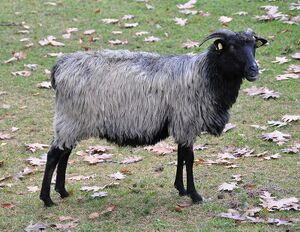Lüneburger Heidschnucke (Lüneburg lamb)

g.U. Lüneburger Heidschnucke is meat produced from Heidschnucke sheep; lean, high quality meat with a gamey flavour.
Geographical area: Former German principality of Lüneburg (now known as the Lüneburger Heide), covering the rural districts of Celle, Gifhom, Harburg, Lüchow-Dannenberg, Uelzen, Lüneburg and Soltau-Fallingbostel.
Proof of origin: Lüneburger Heidschnucke sheep have been raised on the dry heathland of the Lüneburg region for well over a century and a half. Since as far back as 1848 this breed has far outnumbered all other breeds of sheep kept in the former principality of Lüneburg. The heathland area was at its largest extension in the 18th century, due to timber felling and slash-and-bum practices. This encouraged increased growth of heather, which thrives on sandy soils with a low nitrogen content and few nutrients. Since Heidschnucke sheep are a hardy breed, they were able to feed on the woody-stemmed heather even though it provided few nutrients. Lüneburger Heidschnucke sheep have therefore acted as a natural caretaker of the heathland landscape for centuries, making an invaluable contribution to the conservation of this natural landscape by constant browsing.
Method of production:
la) Shepherding in herds of over 100 ewes on heathland and neighbouring areas;
1b) Folding of grazing herds of around 8 ewes and more on grassland (permanent grassland);
2) Meat production in accordance with German and European food and veterinary laws
Link: Lüneburger Heidschnucke sheep feed on heather which is poor in nutrients and therefore slows their growth, producing a very lean meat. The conditions under which Heidschnucke sheep are farmed and their feeding conditions combine to produce the wild-game flavouring typical of this breed. To ensure that the sheep meat is produced in this geographical area and subsequent meat products are processed and manufactured here, holdings that farm Lüneburger Heidschnucke are registered in the area, as are slaughterhouses and catering establishments processing meat from these animals. The origin of the slaughter animals can be traced through their eartag numbers.
Gastronomy: The meat of the g.U. Lüneburger Heidschnucke can be kept in the refrigerator in its original wrapping for a few days. It can also be conserved in the freezer for a longer period. It lends itself to be prepared in various manners, but one of the most traditional ways to enjoy g.U. Lüneburger Heidschnucke is to cook the meat with honey and with berry sauce, sweet-and-sour, serving it with local potatoes, baked in the oven or boiled. It is perfect with beer or full-bodied wines.
Reference: The European Commission
#potatoes #honey #sauce #freezer #game #german #baked #refrigerator #berry #wines #beer